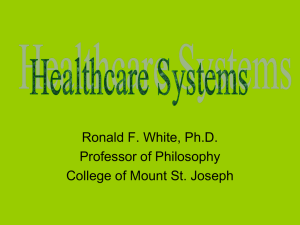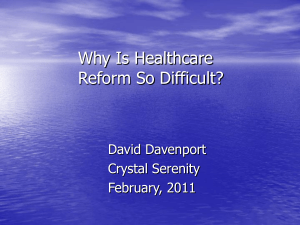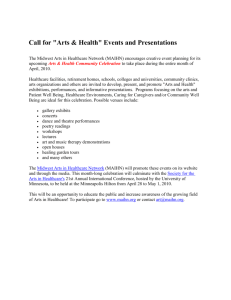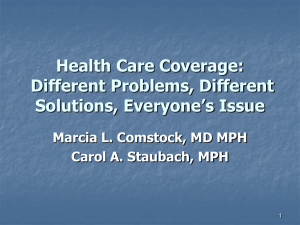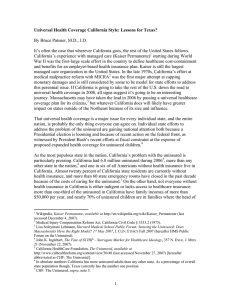Health care Disparities, the Uninsured, and the Role of Physicians in
advertisement
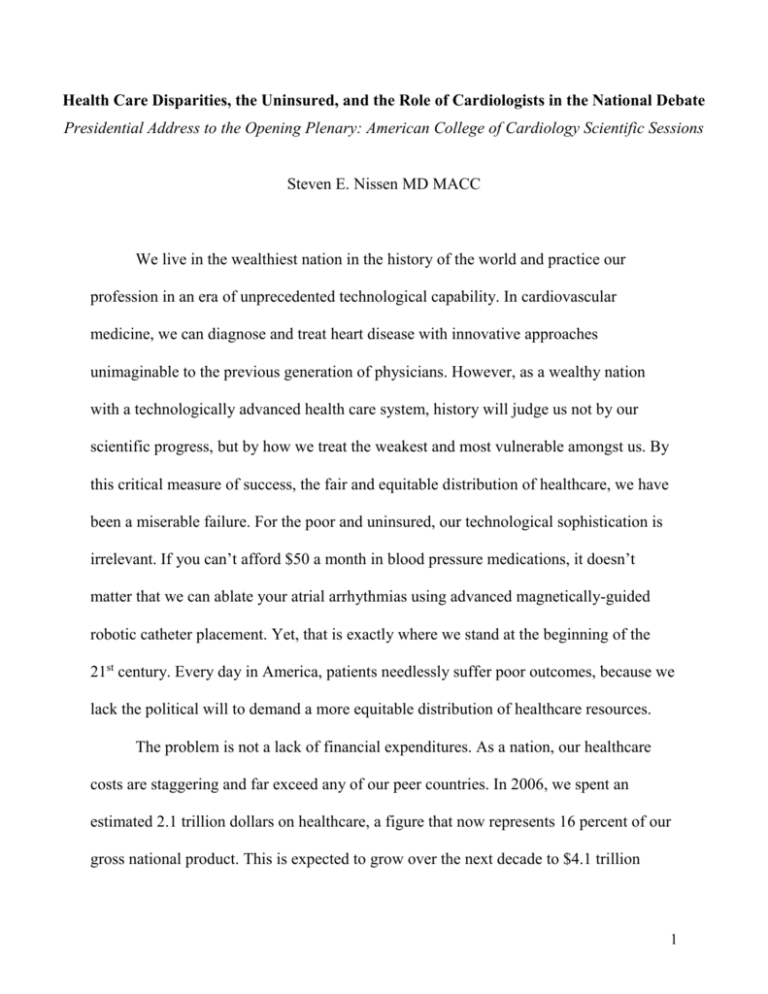
Health Care Disparities, the Uninsured, and the Role of Cardiologists in the National Debate Presidential Address to the Opening Plenary: American College of Cardiology Scientific Sessions Steven E. Nissen MD MACC We live in the wealthiest nation in the history of the world and practice our profession in an era of unprecedented technological capability. In cardiovascular medicine, we can diagnose and treat heart disease with innovative approaches unimaginable to the previous generation of physicians. However, as a wealthy nation with a technologically advanced health care system, history will judge us not by our scientific progress, but by how we treat the weakest and most vulnerable amongst us. By this critical measure of success, the fair and equitable distribution of healthcare, we have been a miserable failure. For the poor and uninsured, our technological sophistication is irrelevant. If you can’t afford $50 a month in blood pressure medications, it doesn’t matter that we can ablate your atrial arrhythmias using advanced magnetically-guided robotic catheter placement. Yet, that is exactly where we stand at the beginning of the 21st century. Every day in America, patients needlessly suffer poor outcomes, because we lack the political will to demand a more equitable distribution of healthcare resources. The problem is not a lack of financial expenditures. As a nation, our healthcare costs are staggering and far exceed any of our peer countries. In 2006, we spent an estimated 2.1 trillion dollars on healthcare, a figure that now represents 16 percent of our gross national product. This is expected to grow over the next decade to $4.1 trillion 1 dollars, nearly 20% of GNP. Per capita, we spend at least 50% more than most Western European countries, and double the expenditures of some. Yet, despite this enormous expenditure, our infant mortality rate is 39% higher than Belgium and 56% higher than Germany. In terms of life expectancy, we now rank 46th among countries of the world, just barely ahead of Albania, living, on average, about 5 years less than our counterparts in the leading countries. With incredible technological advances and a huge national budget for healthcare, why have we failed so miserably to lead the world in public health outcomes? The answer is absolutely clear. We fail, because we provide healthcare unevenly, offering extraordinary benefits to the most economically privileged and inadequate access to healthcare for the weakest and poorest amongst us. It is only fitting that we discuss this subject in New Orleans, a city that has suffered so much during the past 18 months. But we should not forget that healthcare disparities in New Orleans were enormous long before Katrina destroyed the medical infrastructure. In the lower Ninth Ward, a cardiologist who is a prominent member of the College, treated a population in which 50% of his patients were unable to pay for their care. Throughout our nation, there are hundreds of communities like New Orleans, where this pattern of uneven distribution of healthcare results in poor outcomes. In America, we have two health care systems, one for the advantaged and a second, substandard system for the disadvantaged, a group that includes a disproportionate representation of people of color, immigrants (both legal and illegal), women and children, the mentally handicapped, and the working poor. Although I do not 2 have access to statistics, it would be interesting to compare the health of the 250 million Americans who actually have health insurance to other Western nations with universal coverage. I would not be surprised if we rank amongst the best in outcomes using this metric. For the privately insured, we offer outstanding healthcare. Most of the uninsured are hard-working citizens, many of whom toil at the jobs most Americans consider undesirable. Approximately 80% of the uninsured are members of a family with a fulltime worker. These are people we all know – the server in our favorite restaurant, the person who gives us our dry cleaning. Many are not the poorest of the poor. In 2005, the federal government considered the poverty level as an annual income of approximately $20,000 for a family of four. If we consider families with incomes between 100% and 200% of the poverty level (between $20,000 and $40,000 annually), the rate of uninsured families is a staggering 33%. For families with incomes between 40,000 and 60,000 dollars annually, the uninsured rate is still about 16%. How do these figures translate into access to healthcare? In 2005, a survey by the Kaiser Family Foundation found that 31% of the uninsured had no regular source of health care, 35% postponed needed care due to lack of money and insurance, and 36% spent less on basic needs to pay for health care. Parents with children comprise about a quarter of the total uninsured population. Women are disproportionately represented – 20% of women ages 18 to 64 have no health insurance. That figure rises to 38% for Hispanic women. With such statistics, is it any wonder that we rank 46th in life expectancy and have high rates of infant mortality? 3 For our own specialty, the disparities in cardiovascular outcomes for the financially disadvantaged are profound. In a manuscript published just two weeks ago in JAMA, prominent College member Harlan Krumholtz reported that, after a myocardial infarction, patients with financial barriers to healthcare were much more likely to require re-hospitalization, suffer from angina, and have a lower quality of life score. Although we have neglected these problems for decades, the national will to solve the problem of healthcare disparities and access to care seems to have gained considerable momentum during the past two years. Both conservative and liberal politicians have placed this issue near the top of the national agenda. But we have been there before and have always come away empty-handed. This time, we must not fail. A principal question for all the stakeholders participating in this debate is the dilemma of where to find the billions of dollars needed to solve the problem. Often overlooked in this discussion is the concept that we are already paying for the problem of the uninsured. When a patient without health insurance arrives at the emergency room in the middle of the night with a myocardial infarction, often an interventional cardiologist will perform an urgent angioplasty. Who pays the cost for this care? All of us do. Today, with our inequitable healthcare delivery system, we care for many of the poor and uninsured through cost-shifting. Hospitals and physician routinely charge insured patients more than needed, because they must adjust for the likelihood that a proportion of these fees will never be paid. So, in many ways, we are already paying for the uninsured. However, the problem is that the cost-shifting approach does not distribute the burdens 4 equally. At urban hospitals in poor communities, a much higher percentage of care is not reimbursed. This is illogical and unfair. We must distribute these burdens more equitably. We also pay for the lack of universal health coverage through hidden costs. I recently saw a 54 year-old man who works as a janitor for a local business, supporting a family of five with an income only marginally above the defined federal poverty level. This gentleman, otherwise healthy, has significant hypertension and lacks any health insurance. I had not seen him for more than a year when he arrived at our emergency department with a large anterior wall myocardial infarction. Unfortunately, he presented more than 24 hours after the onset of chest pain. After urgent angioplasty, there was essentially “no reflow” in the infarct vessel. He had a stormy post-MI course, complicated by severe LV dysfunction and now has advanced congestive heart failure. I spoke with his wife during his hospitalization, and she told me that her husband was unable to afford his anti-hypertensive medications and had stopped taking them 6 months earlier. She also told me that he delayed coming to the hospital with chest pain, because he lacked insurance and didn’t want to burden his family with added health care costs. Now, with severe heart failure, he is unlikely to return to work. He will eventually become Medicaid eligible, and the State will then assume the cost for his health care. We must also realize that cardiologists are part of the problem. We have not always used costly technologies wisely, sometimes advocating approaches that do not maximize overall healthcare benefits. Recently, I was dismayed when a group of cardiologists advocated expensive imaging tests for virtually all Americans over the age of 45 to detect subclinical atherosclerosis. We simply cannot spend billions of dollars so 5 recklessly, when we are consuming 16% of our GNP on health care and there are still 47 million Americans with no health insurance. The efforts of the College to promote “appropriateness criteria” for these technologies can play a pivotal role in containing costs, thereby freeing significant resources to provide coverage for the uninsured. As an organization, we must support the adoption of these appropriateness guidelines, so that we minimize health care costs, while maximizing quality. Ultimately, universal health insurance represents the only acceptable solution to resolving the problem of healthcare disparities. Unfortunately, there are now a bewildering array of proposals originating from the federal government, business leaders, states, and advocacy groups. A complete analysis of these proposals is beyond the scope of this talk, but several principals make good sense. The Bush administration has offered some useful concepts, suggesting tax relief for individuals who directly purchase health insurance. This initiative would help level the playing field by allowing similar tax advantages for individuals and employers. Medical liability reform is essential. By reducing the burden of the high costs of malpractice coverage and minimizing unnecessary “defensive” medicine, we create a more cost-effective delivery system. Federal support for health information technology, including fully electronic medical records, can also dramatically improve efficiency and effectiveness, providing higher quality care, while lowering costs. Making health insurance portable represents another excellent idea, allowing individuals who change jobs to keep current coverage. However, while useful, the President’s proposals do not go far enough. They help address the issues for some working Americans, but leave large gaps in coverage for tens 6 of millions of others. In my view, extending employer-based health insurance represents a critical component of health care reform. A major obstacle to universal coverage is the high cost of premiums for full health insurance coverage, which now averages nearly $11,000 annually for a family of four. One incremental idea is the mandatory requirement that employers offer a high-deductible health insurance plan to all employees. Proponents argue that this would provide at least basic coverage to many millions of Americans without burdening employers to the point of non-competitiveness. A few reform advocates continue to support a universal single payer system. While this would certainly provide complete coverage, the downsides are substantial and because this approach limits individual choice, it is unlikely to gain broad national support. Out of frustration with the inability of the federal government to solve the problem of the uninsured, several states have offered their own healthcare reform initiatives. California governor Arnold Schwarzenegger has proposed the requirement for all state residents to have health insurance coverage. The governor’s plan would provide statesubsidized coverage for all children living below 300% of the federal poverty levels. Families between 100% and 250% of the poverty level, would be offered coverage via a state purchasing pool. These low-income families would provide 3-6% of their gross income as a mandatory co-pay. Employers with 10 or more employees, who choose not to provide coverage, will be required to pay an amount equivalent to 4% of their payroll toward the cost of employees’ health coverage. The California plan would direct 10-15 billion dollars to hospitals and doctors, who, in turn, would contribute 4% and 2% respectively, of their gross revenues to assist with indigent care. The appeal of the 7 California plan is that it spreads the costs amongst individuals, employers, physicians, and the State. There are many other state initiatives underway, including comprehensive plans in Massachusetts, Maine, and Vermont. In addition, there are plans for covering all children in Illinois, Pennsylvania and Tennessee. The Massachusetts plan is the most advanced and comprehensive, providing employer mandates for health coverage for companies with 11 or more employees. The Massachusetts plan also creates a subsidized slidingscale insurance plan for families below 300% of the federal poverty level. Despite the appeal of state plans, in my view, the major value of these state-by-state efforts is to raise awareness and serve as an incubator for ideas that would optimally be implemented nationally. So I pose this question to you, my colleagues and fellow members of the College. What should be the role of physicians and the American College of Cardiology in this great national debate? We could sit on the sidelines and wait for the legislative branch to arrive at a solution to the problem. We could be reactive, offering commentary and critique as various plans are introduced. We could defend our economic interests, making certain that we recover our share of the increased expenditures. Or we could be proactive, vigorously engaging in the process, proposing innovative solutions and passionately advocating on this issue with our colleagues, our patients, in the media, and within the halls of Congress. I want our profession and our College to lead the way. No one better understands the needs of our patients and our profession. We understand healthcare in 8 ways no politician can possibly master and we have the creative energy to be a key source of innovation in seeking solutions to these daunting problems. Let’s get engaged. 9


